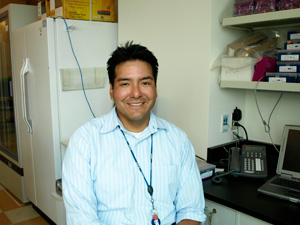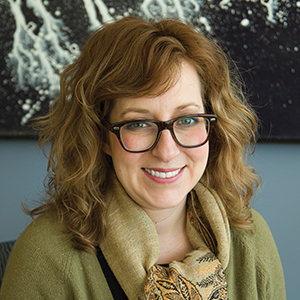A life of, and for, change
Where Dave R. Wilson, the newest member of the American Society for Biochemistry and Molecular Biology Minority Affairs Committee, grew up in rural New Mexico, opportunities for upward mobility – and, well, even neighbors – were few and far between. Nestled in the Navajo Nation Reservation not too far from the Four Corners, his hometown had only four houses, and his school was an 18-mile bus ride away.
As a boy, Wilson was studious. He wanted to become an engineer, as mining was a primary source of income for the locals, including his coalminer stepfather. His grades earned Wilson a full ride to major in mechanical engineering at the University of Arizona in Tucson, but he soon became dissatisfied with the track. Then a summer spent chasing butterflies changed everything.
 |
| Dave R. Wilson visits with Catherine Woteki, the U.S. undersecretary for research, education and economics, and shows her "Flat Stanley," who was drawn by his nephew in Arizona. Flat Stanley's adventures in Washington were shared with his nephew's second-grade class. |
Taking flight
The flier for the summer program promised six weeks of research at the Rocky Mountain Biological Laboratories in Gothic, Colo. Instead, it delivered something far more awesome: Goloptus psychlictuimus. Wilson, then a sophomore, investigated why the silvery blue females lay their eggs on certain plant calyxes, and he found that the calyxes were toxic to cows, making the offspring quite unlikely to get gobbled up. Wilson was hooked on biology.
Giving up his scholarship, Wilson moved to Phoenix, where he had family, and transferred to Arizona State University in nearby Tempe to major in molecular and cellular biology. He received some federal aid and took a job at a local environmental lab startup that tested for water quality, food contamination and soil contents. He worked hard and rose to director of chemistry, then director of microbiology, and then to director of research and development. After graduation from ASU, he stayed on, making a good living. But he found himself once again yearning for something more.
A clean slate
At the urging of his wife, Paty, Wilson quit the lab. They sold their belongings and, with a newborn in tow, moved in with relatives there in Phoenix. Wilson applied to the Ph.D. program at Arizona State – and nowhere else. No one in his family had gone to graduate school, he explains, so he didn’t know any better. He got in.
True to form, Wilson excelled and went on to do a three-year postdoctoral stint at the National Institutes of Health. He was promoted to senior research scientist at the National Institute on Aging, where he studied sirtuin 6 and got his first taste of minority outreach, another passion he decided was worth risking it all.
Drawn in by outreach
The summer leadership institute offered by SACNAS, an organization focused on the advancement of Hispanic, Chicano and Native American scientists, promised to help Wilson and the other 29 participants find out how they could engage underrepresented minorities in science. For Wilson, it did much more.
“My career came to a crossroads,” he explains. “I was wondering whether it was more beneficial for me to be the lone Native American scientist doing elite research at the government or whether it was more important for me to help promote opportunities and share my experiences with upcoming Natives who were going through the same struggles.” It was a difficult decision. For eight months, Wilson weighed his options, consulting with investigators at NIH, his family and his friends. Then he took a leap of faith, again.
Settling in at SACNAS
For the past 15 months, Wilson has been director of Native American initiatives at SACNAS, a job that involves creating programming that builds young Native Americans’ research and professional skills. The three primary challenges faced by young Native Americans considering careers in science, Wilson said, are accessibility to information, family support and access to minority mentors at all levels.
One program Wilson helped spearhead is set to launch this fall at Oklahoma State University. It’s called Science Scholars: The Native American Path, or SSNAP. “We want to target Native Americans in a cohort approach,” he explains, “so we are selecting 30 (undergraduate) students who are in biomedical sciences.” OSU was chosen for its record number of Native American students graduating with bachelor’s degrees in the sciences.
Wilson has teamed up with bacteriologist Gilbert John at OSU, who also is a Navajo, to create a curriculum covering lab work, oral and poster presentations, and negotiations and queries for funding and employment opportunities. He’s also working closely with another new hire at SACNAS, physicist Yvonne Rodriguez, who oversees the society’s programming. Wilson emphasizes that he doesn’t want the OSU effort – or any of the SACNAS efforts, for that matter – to be just another program that sounds nice in principle but doesn’t have measureable results.
“We want to produce more outcome-based programming,” he says. “Being scientists, that’s what we’re all about.”
Seeking efficiencies
 |
|
Dave R. Wilson completed a three-year postdoctoral stint at the National Institutes of Health. He was then promoted to senior research scientist at the National Institute on Aging, where he studied sirtuin 6 and got his first taste of minority outreach. |
Meanwhile, at the NIH, a newly formed group of professionals has been meeting on a monthly basis to talk about minority representation throughout the agency and to find ways to attract minority scientists to the campus. The group, SACNAS’s first professional chapter, is another Wilson brainchild, and he’s optimistic about what it might achieve.
“The federal dollars are tight these days. If all these agencies are able to understand what services or what programs (to recruit minorities) exist and what they provide, they can work together to fill positions that need attention” and maximize taxpayer dollars, Wilson explains. Today the chapter has 60 members, and Wilson anticipates it will have 200 once it’s in full swing.
Teaming up
One of SACNAS’s recent initiatives is to forge relationships with scientific associations. “My goal is to be able to connect professionals,” Wilson says. “There’s been this outcry … about how we get professional societies more involved with our membership.”
One way, Wilson determined, is to get in the trenches of professional societies and find out how their missions align with that of SACNAS. So last year Wilson joined the ranks of the ASBMB Minority Affairs Committee. In just a few short months, he’s already found synergies: research funding and work-force development.
“Now young postdocs are coming out of their training and are competing with people who’ve had tenure and lost their position,” he says. “Because the NIH funding has remained flat and the NSF only had a 3 percent increase this year, nothing is going up. So the new investigators who are coming up – there’s no money for them.”
Wilson regularly serves on federal and White House roundtables, weighing in on policy matters in the interest of scientists both young and old. One recurring discussion is about the training of graduate students and postdocs for career alternatives outside academia. “It’s important,” he says, “to inform trainees that there are so many different positions that need scientific expertise that aren’t getting public exposure.”
A whole new world
Wilson is living proof that skills learned in the lab are transferrable. He credits his family and mentors with giving him the support and advice he needed to change gears time and again. He says he’s glad he’s rolled the dice and landed at SACNAS this time. “I had this unique opportunity I had to take and run with!”
Enjoy reading ASBMB Today?
Become a member to receive the print edition four times a year and the digital edition monthly.
Learn moreFeatured jobs
from the ASBMB career center
Get the latest from ASBMB Today
Enter your email address, and we’ll send you a weekly email with recent articles, interviews and more.
Latest in Careers
Careers highlights or most popular articles

Building the blueprint to block HIV
Wesley Sundquist will present his work on the HIV capsid and revolutionary drug, Lenacapavir, at the ASBMB Annual Meeting, March 7–10, in Maryland.

Upcoming opportunities
Present your research alongside other outstanding scientists. The #ASBMB26 late-breaking abstract deadline is Jan. 15.

Designing life’s building blocks with AI
Tanja Kortemme, a professor at the University of California, San Francisco, will discuss her research using computational biology to engineer proteins at the 2026 ASBMB Annual Meeting.

Upcoming opportunities
#ASBMB26 late-breaking abstract submission opens on December 8. Register by Jan. 15 to get the early rate on our Annual Meeting.

Make your abstract stand out
Ensure your research is impossible to overlook. Get quick, practical reminders for crafting an abstract that attracts readers and helps you build connections at the conference.

Inside industry postdocs
As more Ph.D. scientists look beyond academia, industry postdocs offer a new kind of training, where mentorship meets mission-driven research. Fellows at Pfizer and Genentech share how these programs prepare them to translate discovery into impact.

